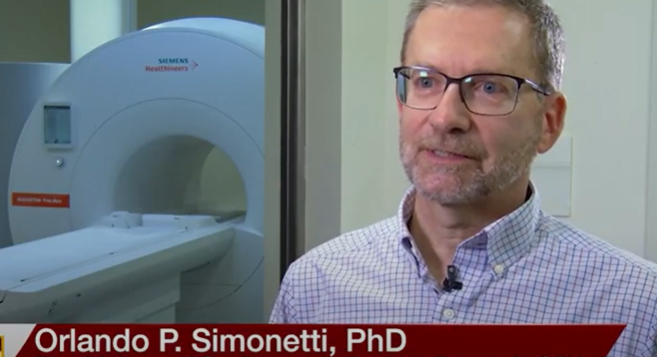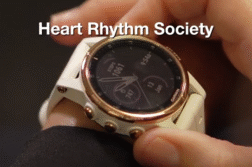Orlando P. Simonetti, PhD, Director of Advanced Cardiovascular at Imaging Research, talks about how MRIs can be a great way to detect internal injuries, heart diseases, and cancer. But MRIs can also be a great tool to pick up on other medical issues and problems and ensure everyone can get a screening.
Interview conducted by Ivanhoe Broadcast News in April 2022.
I wanted to start broadly by having you tell me a little bit about the new machine that you’re using. What are its chief uses? What is it best for?
SIMONETTI: We focus on cardiovascular imaging here in this center. And this is the Siemens MAGNETOM Free. Max MRI system that was just released last year by Siemens. We were one of the first in the country to get this machine installed, and that was due to our research collaboration with Siemens that’s been ongoing over the past 17 years here at Ohio State.
What’s different about this machine? What upgrades does it have?
SIMONETTI: A number of things. It’s a lower magnetic field strength. So, this is at .55 Tesla, where the clinical machines in widespread use are typically either 1.5 Tesla or 3 Tesla. In fact, right next to us here, there’s a 3 Tesla magnet installed. And that brings several advantages and disadvantages. There are tradeoffs in MRI that lower field strength brings. One disadvantage is that the MRI signal is dependent on the field strength so, this just comes with a lower signal. But we’ve developed techniques to extract more signal out of our images by different methods of processing that data that comes from the MRI scanner. So, we can overcome the signal loss. And then, there are several advantages of lower field as well.
What’s the advantage of having a lower field?
SIMONETTI: There are several. One, the magnet design becomes more flexible at lower field. So, this is actually an 80-centimeter patient where most clinical magnets are either at 60 or 70 centimeters. And that doesn’t sound like much of a difference, but you can really appreciate it that we can fit the largest of patients and patients with claustrophobia are less bothered by the openness of this magnet. So, we actually are just starting a big project here now, an NIH-funded project, to develop cardiovascular MRI techniques for the severely obese patient population. They often suffer from cardiovascular disease. Heart failure is common. And not only can those patients not fit in a conventional MRI, but other imaging modalities like echocardiography, CT, and nuclear imaging are not as effective in these severely obese patients. So, we’re hoping that with this machine, we can provide high quality imaging for cardiac disease in that patient population.
In an obese patient, what would doctors be looking for from these images? What is the benefit of having them get the scan and the report be?
SIMONETTI: Like anybody, they can be afflicted by different types of cardiovascular disease. But heart failure is especially prevalent. Heart failure means reduced cardiac function. So, we can assess cardiac function. But what also accompanies that often is scarring or fibrosis of the heart muscle. And MRI is the best modality to detect that. And that has strong prognostic implications. So, we’re hoping we can better guide the treatment and therapy for those patients by opening up the ability for them to get an MRI.
What are some of the other benefits of having that lower magnetic field?
SIMONETTI: A lot of our patients that come in for cardiac MRI have implanted devices. Then, we can at higher fields, so there’s opportunities there to do functional lung imaging with MRI. So, looking at ventilation, perfusion, lung function, things that are typically done with nuclear imaging. So, we can do that again without radiation and perhaps better than with other modalities.
Do you have a project that you’ll be starting, or you haven’t started bringing patients in yet?
SIMONETTI: The system came without any cardiac techniques. It came with general purpose kind of knee, spine, brain imaging techniques. So, we’ve been working closely with Siemens, the manufacturer, to build those cardiac imaging pulse sequences. And we’re almost there, now. So, next week, it looks like we’ll bring our first research patients in. We’ve had healthy volunteers come through that we’ve scanned to test these techniques, but now, we’re ready to start testing on some patients who’ve had an MRI at higher field. We can compare the images that we get there, make sure that we can see everything we need to see. And then, we’ll start with the severely obese and claustrophobic patients. We’ve already got a waiting list of people who’ve come in right here for this MRI next door, haven’t been able to get in or when they get in, they’re so uncomfortable that they can’t get the scan done. So, we’re going to start with those patients here where they have no other option.
At what Tesla are you comparing?
SIMONETTI: It’s 1.5 Tesla and 3 Tesla. We would compare both. We have three magnets dedicated to cardiovascular imaging here at Ohio State with the three different field strengths – 1.5, 3 and now .55. And that’s unique to anywhere in the world where they’re dedicated to cardiac imaging. So, it’ll enable us to put the patient in the machine that’s most appropriate for them.
Can you go over the current research and upcoming research and then finish with the DOD grant that you got?
SIMONETTI: Currently, what we’re doing here is, as I mentioned, we’re developing the techniques that we’re going to use for clinical cardiac imaging, routine stuff that didn’t come with the scanner, but we need to build. The NIH-funded project that we have is to develop those techniques specifically for the severely obese population that really isn’t served by other imaging modalities or by MRI because many times they can’t fit in the magnet. So, that’s one ongoing project. The development of MRI-guided cardiac interventions in collaboration with Nationwide Children’s Hospital. That’s also ongoing research here. What we’re going to start soon is we received word from the Department of Defense that we’ll be funded for a project. And that’s to look at diet interventions in heart failure. So, it dovetails into the work that we’re doing to develop techniques for the obese population. I expect some of the patients that enroll in that trial, while it’s a study of diet interventions, we’re going to be using cardiac MRI to assess the impact of those interventions on their cardiovascular disease. And I’m sure some of those patients will be scanned here because of the wider bore. And then, lung imaging is a project that we’re just getting started with. There are some chest radiologists very interested in that and cardiologists who work in pulmonary hypertension. So, there’s a link between cardiac and pulmonary disease in many cases. And this may give us the opportunity to assess both in a single exam.
The benefit is because you’re dealing with pediatric patients, do you want them to have that full dose of radiation or magnet strength if they don’t have to?
SIMONETTI: No. There are no safety concerns regarding the magnetic field strength. But when Dr. Amy Armstrong, at Nationwide Children’s Hospital, does these catheterizations, it requires using a guidewire catheter. And those can heat up at higher field strength. So, there’s been a lot of work over the years to develop special devices that don’t heat up at higher field strength. But they’ve never had the kind of mechanical properties that the interventionalist is looking for. They can see the images, but a lot of it is by how things feel when they’re running these catheters in. Now with this machine, we can use several conventional guidewires, just off-the-shelf equipment because at lower field they don’t heat up. So, she can use the equipment that she’s used to and has the feel that she’s looking for while using MRI to guide the procedure.
What are the patient benefits to having images in something like this?
SIMONETTI: Some of the advantages I mentioned. I guess the open bore will be more comfortable for most people, whether severely obese or claustrophobic. But for anybody, it’s more comfortable. If you have a device, as we mentioned, you’re going to likely get better image quality here with that. This should reduce the cost of the system. Whether that gets passed down to the patient is another question. It’s a complicated health care system we have. But it should help with dissemination of this technology. It’s a lighter weight machine. It’s lower cost and it’s smaller. So much easier to install in places where MRI maybe wouldn’t typically be found, like in an emergency room or in a cardiology department. So, I’m expecting this will open opportunities for MRI that way.
Is there anything else that you would want to make sure people know?
SIMONETTI: Another big potential advantage for low field is lung imaging. So, the lungs are a mix of air and water and the signal that’s there is low. But also, at higher field strength, the signal tends to cancel out because of the variation in the magnetic field because of the mix of air and water. And that’s not as much of an effect at lower field. So, that’s kind of an exception where we can actually get more signal out of the lung tissue at low field.
END OF INTERVIEW
This information is intended for additional research purposes only. It is not to be used as a prescription or advice from Ivanhoe Broadcast News, Inc. or any medical professional interviewed. Ivanhoe Broadcast News, Inc. assumes no responsibility for the depth or accuracy of physician statements. Procedures or medicines apply to different people and medical factors; always consult your physician on medical matters.
If you would like more information, please contact:
Amy Colgan Eileen Scahill
Amy.colgan@osumc.edu Eileen.scahill@osumc.edu
Sign up for a free weekly e-mail on Medical Breakthroughs called First to Know by clicking here





